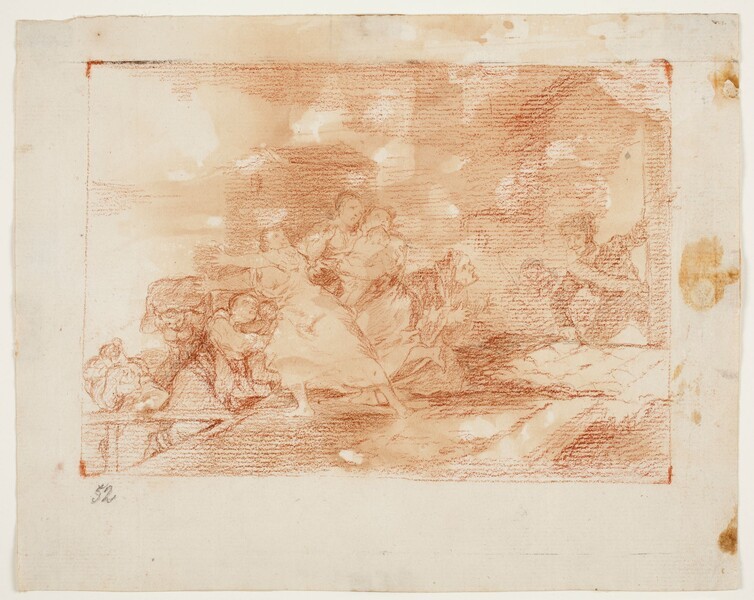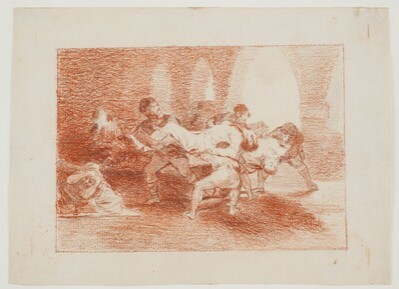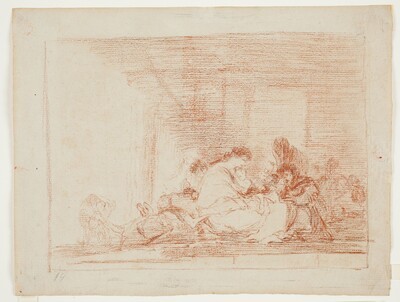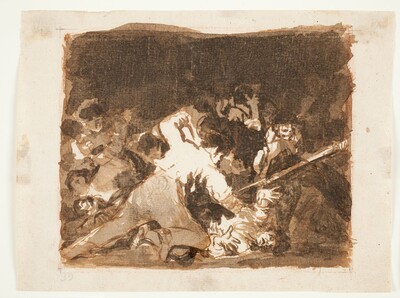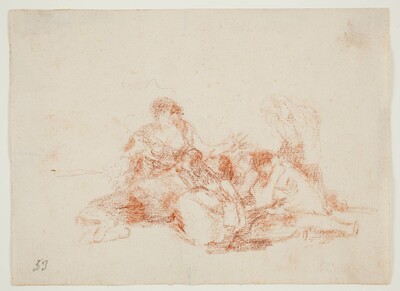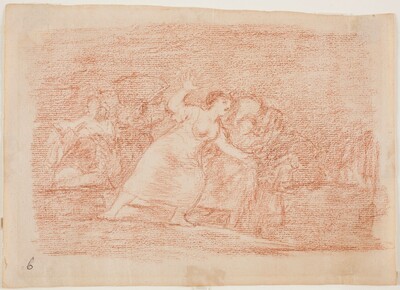- Cronología
- Ca. 1810 - 1814
- Ubicación
- The Prado National Museum. Madrid, Madrid, Spain
- Dimensiones
- 187 x 238 mm
- Técnica y soporte
- Reconocimiento de la autoría de Goya
- Documented work
- Titular
- El Prado National Museum
- Ficha: realización/revisión
- 20 Aug 2021 / 25 May 2023
- Inventario
- D3988
52 (in black pencil, lower left)
Fine frame in sanguine, raised angles, copper mark
In the Prado Museum has examples of preparatory drawings from all the series of engravings Goya produced throughout his career. Almost all of them, with a few exceptions, come from the collection of Valentín Carderera (1796-1880), whose heir, Mariano Carderera, sold a lot of 284 preparatory drawings to the Prado Museum in 1866. The Prado Museum has 75 of the preparatory drawings for the Disasters of War series, some of which, such as Women Surprised by Soldiers, were never engraved.
Line of provenance: Javier Goya, 1828; Mariano Goya, 1854; Valentín Carderera, ca. 1861; Mariano Carderera, 1880; Prado Museum, 12/11/1886.
In several of the series of prints ("Copies of Velázquez", "Caprichos" and " Bullfighting") that Goya produced over the course of his career, there were cases of preparatory drawings that were not included in the final series, even though some of them had traces of having been transferred to the plate by means of the etching press. This is the case of eight drawings with a war theme executed in connection with the so-called Disasters of War (1808-1814), which evoked the tragic events of the War of Independence and were not included in the definitive series. In fact, Gassier and Wilson have already noted that four of them bear telltale marks of having been reported on copperplate but no proof is known. Red chalk is the main material used in the preparatory drawings for the Disasters, and this is indeed the technique used in these additional drawings. Thus, in Women Surprised by Soldiers, we find an example of a drawing that has been reported, as evidenced by the marks left by the copper, but for which no evidence has survived.
The composition is very similar to that of another drawing also entitled Women Surprised by Soldiers. On what appears to be a rooftop, a group of women refugees has been discovered by a pair of smiling enemy soldiers, who are peering through an archway of the buildings that frame the scene. An old woman in the centre of the composition seems to be pleading for mercy with open hands. At the same time, a mother in the central group holds her infant son to her breast. In the foreground, another young woman, dressed in a white nightdress revealing her breasts, flees in panic to the left. The panic and agitation of the moment are reflected by Goya in a dynamic and complex composition spread over several planes.
Heavily soiled paper
-
Goya (1746 – 1828)Galleria Internazionale d’Arte Moderna di Ca’PesaroVenecia1989consultant editor Antonio Fortún Paesa. From May 7th to July 4th 1989
-
Los dibujos de Goya, 2 vols.MadridAmigos del Museo del Prado1954s. p., cat. 148
-
OxfordBruno Cassirer1964vol. II, p. 298 (il.), cat. 203a
-
Vie et ouvre de Francisco de GoyaParísOffice du livre1970p. 276, cat. 1142
-
Dibujos de Goya, 2 volsBarcelonaNoguer1975pp. 314-315 (il.), cat. 232
-
Madridhttp://www.museodelprado.es/En línea
